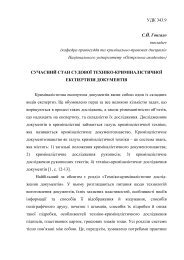Download (3187Kb) - ÐÑÑÑозÑка академÑÑ
Download (3187Kb) - ÐÑÑÑозÑка академÑÑ
Download (3187Kb) - ÐÑÑÑозÑка академÑÑ
Create successful ePaper yourself
Turn your PDF publications into a flip-book with our unique Google optimized e-Paper software.
Фінансова система України. Частина 1. 9sensitivity for sound transition strategies under starting conditionsand its results, especially on capital markets [14].Since exchange rate regimes matter for the persistence ofinflation,[15] the exchange rate policy should adopt an appropriateregime, which enables the central bank to react to external shocksquickly. Beside that it has to take the state of transition intoaccount, because the liberalization of administered prices triggersan inflationary adjustment impulse. Usually, food and administeredprices have also a greater weight in the consumer price index than inadvanced economies. Several central banks of transition countriesaddressed this issue explicitly when choosing among monetarypolicies [16].But the exchange rate policy does not work for its own sake. Itis a means to reach a policy goal. And since inflationary pressurescan be huge in transition, the central bank should consider waysto influence inflation. Inflation itself has a rather calculablecomponent, the real inflation rate, and a rather fluctuating one,namely inflation expectations. When inflation expectations areanchored sufficiently, the risk of second round effects is far less.There is also recent evidence suggesting that inflation andinflation expectations are better anchored in inflation targetingeconomies than in non-inflation targeting economies with noadverse effect on output. Beside that, with inflation-targetinginterest rates, exchange rates, and international reserves areless volatile, and the risk of currency crisis relative to money orexchange rate targets is lower [17].Another result from less volatile inflation expectations is anextension of the maturities of fixed income products. As often inemerging economies, their bond markets lack seize and liquidityand result in a quite short yield curve, because investors considerthe possession of long bonds too risky. As the experience of Mexicoin the mid 1990’s shows, by anchoring inflation expectationsbetter, volatility of long term bond yields is decreasing and givesinvestors more reason to hold such bonds. Apart from this, a longeryield curve with interest rates determined by the market increaseseffectiveness of monetary policy.Alternative indicators to inflation targeting like targetingmonetary aggregates are far less reliable in their predictability offuture inflation. Especially in EmMa’s with an often high speedof monetarization, a high growth of monetary aggregates oftenindicates rather a deeper financial penetration than an increasein inflation. However, although there are examples of advancedeconomies (USA, EU) with low correlation between money
















